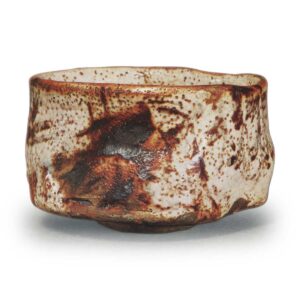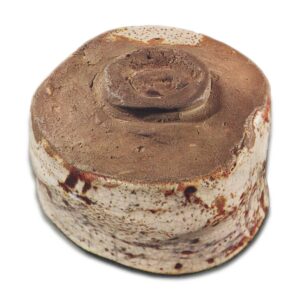

Height: 8.7 to 9.0 cm
Diameter: 11.0 to 13.4 cm
Outer diameter of foot: 5.5 to 6.2 cm
Height of foot: 0.7 to 0.9 cm
At first glance, this tea bowl is full of the atmosphere of the Momoyama period. Some of the painting looks like the wings of a flying heavenly nymph, and the name is thought to be based on this. Along with “Uka-gaki” and “Hirosawa”, it is considered to be one of the most famous Shino bowls. The low, flat base of the bowl extends outwards to form a sturdy, stable waist. In particular, the outer bottom surface is almost entirely exposed, and the unique clay taste and the moderate coarseness of the brushwork are in perfect harmony. The foot ring, which has been roughly cut out, and the generously spreading bottom surface are a great visual and tactile attraction.
As promised by the Koshi ware, the clay is a rough example of mugusa clay, but perhaps due to the slightly higher iron content, the grayish yellow color is slightly deeper than normal. The color of the glaze, which can be seen in the thin areas of the glaze, is due to the effect of the iron content of the clay. The undulations and changes in the upper and outer surfaces are very pronounced. While forming the piece on the potter’s wheel, the monotonous curves of the wheel were changed almost without a trace, using the fingertips, the palm of the hand, and a spatula. The slightly thick rim is gently undulating, showing a relatively gentle rise and fall, and is rather quiet.
The effect of distortion on all sides is sculptural, and the shape is fluid and does not remain as a single, uniform shape when viewed from any angle. The severe distortion of Oribe tea bowls is a further development of this tendency, but Hagoromo has a particularly strong individuality in this respect.
The milky feldspar glaze has visible cracks all over the surface, and there are also many small holes, giving the glaze a complex appearance that is commonly referred to as “yuzuhada” (yuzu skin). The inside of the bowl is wide and smooth, and the glaze is applied evenly and generously, so it has a beautiful white, moist sheen. In contrast, the thickness of the glaze layer on the outside is inconsistent, depending on the changes in the surface of the vessel, and in the thinner areas, the texture of the clay can be seen through, giving the appearance of a slightly rough surface.
Furthermore, the dark and light shades of the glaze are clearly visible in these areas, and in some places, a beautiful, fiery red color can be seen.
The design consists of lines and brushstrokes that are almost completely meaningless. In particular, on the part that seems to be the front of the bowl, there is a rough brushwork that looks like it has been roughly painted with a strong, violent brushstroke, and because the glaze layer in that part is thin, the coloring of the iron in the base material and the dark, sooty burn marks on the demon plate overlap, creating a tone similar to that of broken ink in a sumi-e ink painting. This is the most attractive and mysterious part of this bowl.
In other places, it looks like a picture of a tree or a bridge. The part that looks like the angel’s feathered robe is just two brushstrokes that make no sense. However, this meaningless decoration actually suits the tea bowl’s varied shape and color. The simple black mountain path pattern near the rim on the inside is also effective.
It was kept in the secret collection of the Teramura family, a wealthy merchant family in Kyoto’s Teramachi district, but in 1917 it was passed on to Shirai of Osaka’s Kodaimaru, and later passed to another family in the same area. The Teramura family was a tea family that was said to be one of the three Yabuuchi-style tea families, along with the Nakamura and Yasumura families.
The accessories are a bag with a plaid pattern belonging to the Shijiragami school, and the inner box has a written inscription on the underside of the lid reading “Joshin-sai”, and the lid itself has a written inscription on the top reading “Ryoryo-sai”, and it comes with a cedar outer box.



